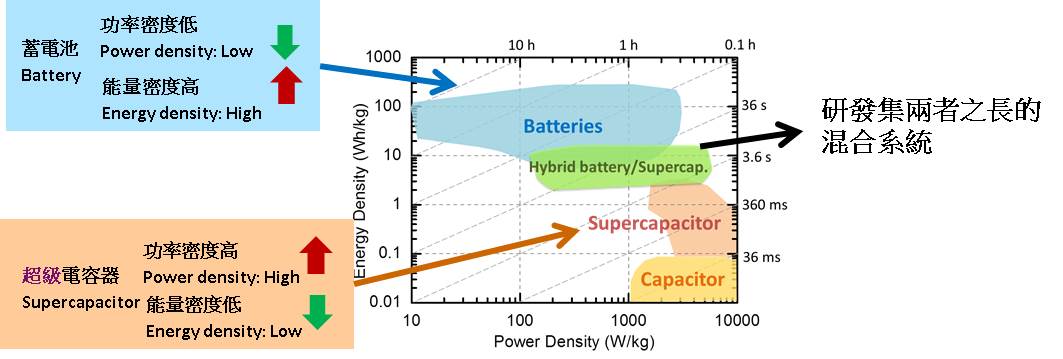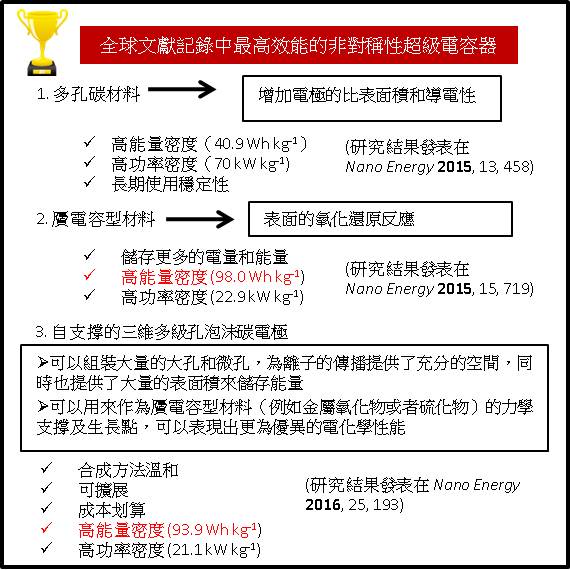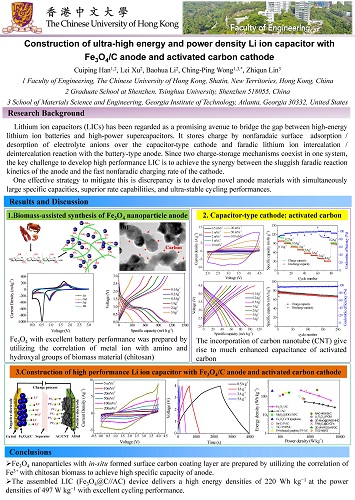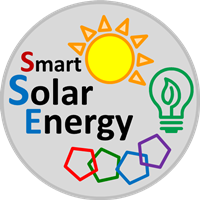Subtopic 4: Energy Storage
三維多孔碳高效能超級電容器
3D porous carbon foam based composites for high performance supercapacitors
汪正平教授及趙鈮教授,香港中文大學,電子工程系
Prof. Ching-ping Wong and Ni Zhao, Department of Electronic Engineering, The Chinese University of Hong Kong
汪正平教授與香港中文大學電子工程系的趙鈮教授合作開展了先進超級電容器的研究。一般來說,超級電容器的功率密度高但能量密度低,而蓄電池則反之。為了提高超級電容器的能量密度,發展多孔碳材料以及贗電容型材料更為適合。因為多孔碳材料(特別是石墨烯)可以增加電極的比表面積和導電性,而贗電容型材料通過表面的氧化還原反應可以儲存更多的電量和能量。
該研究團隊證實了一種低溫的化學沉積法製備高品質的三維彎曲石墨烯材料,並應用於超級電容器,可以實現高能源密度(40.9 W h kg-1)和高功率密度(70 kW kg-1),以及長期的使用穩定性。該研究結果發表在Nano Energy 2015, 13, 458。另外該研究團隊還開發了一種可以自支撐的三維多級孔泡沫碳電極,其合成方法溫和,可擴展並成本划算。該多級孔結構可以組裝大量的大孔和微孔,為離子的傳播提供了充分的空間,同時也提供了大量的表面積來儲存能量。此泡沫碳可以用來作為贗電容型材料(例如金屬氧化物或者硫化物)的力學支撐及生長點,可以表現出更為優異的電化學性能,主要表現為高的能量密度和高功率密度,分別為93.9 Wh kg-1和21.1 kW kg-1,此數值可媲美報導過的最高的非對稱性超級電容器的性能。該研究結果發表在Nano Energy 2016, 25, 193。
Prof. Ching-Ping Wong collaborated with Prof. Ni Zhao in the Department of Electronic Engineering on the research of advanced supercapacitors. In general, supercapacitors show high power density, but suffer from low energy density; while batteries exhibit high energy density but low power density. To increase the energy density of a supercapacitor, it is desirable to use porous carbon materials and highly pseudocapacitive materials, as porous carbon materials (especially porous graphene) can increase the specific surface area and electrical conductivity, while the surface redox reaction occurred in the pseudocapacitive materials can store more energy.
The research group demonstrated a low-temperature chemical vapor deposition method to grow high-quality three-dimensional (3D) curved graphene, which can be used as the supercapacitor electrode to deliver high energy density (40.9 Wh kg-1) and power density (70 kW kg-1) as well as long-term stability. (See Nano Energy 2015, 13, 458.) Another hierarchically carbon-based free-standing 3D electrode was fabricated via a facile, scalable, and cost-effective route. The hierarchically porous structure integrates a lot of macropores and micropores, thus providing sufficient space for ion transport while offering a large amount of surface sites for energy storage. In addition, the carbon foam can be used as a mechanical support for pseudocapacitive materials (metal oxides or sulfides), showing even better electrochemical performance with a high energy density of 93.9 Wh kg-1 and a high power density of 21.1 kW kg-1, among the highest reported values for asymmetric supercapacitors. (Nano Energy 2016, 25, 193.)


相關文獻 Related Papers:
- Jizhang Chen, Junling Xu, Shuang Zhou, Ni Zhao* & Ching-Ping Wong*. (2015) Template-grown graphene/porous Fe2O3 nanocomposite: A high-performance anode material for pseudocapacitors. Nano Energy, 15: 719–728 [Link]
- Jizhang Chen, Junling Xu, Shuang Zhou, Ni Zhao* & Ching-ping Wong*. (2016). Nitrogen-doped hierarchically porous carbon foam: A free-standing electrode and mechanical support for high-performance supercapacitors. Nano Energy, 25: 193-202. [Link]
 |
|
| Project Leaflet 研究計劃簡介 | Poster 海報介紹 |
Video demonstration 短片介紹:
Related news articles:
 |
CUHK Press Release 香港中文大學新聞稿 [14 Sep 2016] Related news articles: |
|
|
CUHK Bulletin No.1, 2016 [15 Aug 2016] |
||
 |
CUHK Feature Story 中大特寫 [25 Apr 2016] |
|
Copyright © 2014 Faculty of Engineering, The Chinese University of Hong Kong. All rights reserved.

